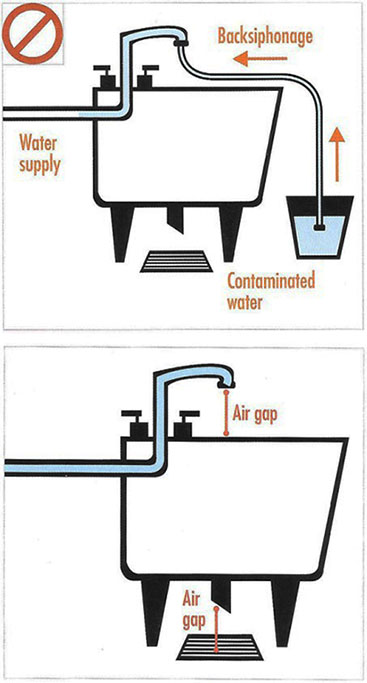Chapter 9: Safe Facilities and Pest Management
Interior requirements for a safe operation
- Floors, walls and ceilings must be smooth and durable for easier cleaning and regularly maintained.
- Foodservice equipment must meet these standards if it will come in contact with food: nonabsorbent, smooth, and corrosion resistant; easy to clean; durable; resistant to damage.
Floor-mounted equipment must be either six inches off the floor or sealed to a masonry base. Tabletop equipment should be four inches off the floor or sealed to the countertop. Once the foodservice equipment has been installed it must be maintained regularly. Only qualified people should maintain it. Set up a maintenance schedule with your supplier or manufacturer and check the foodservice equipment regularly to make sure it is working correctly. Dishwashing equipment must be installed so it is reachable and conveniently located; in such a way that keeps utensils, equipment, and other food-contact surfaces from becoming contaminated; following the manufacturer’s instructions. When selecting dishwashing equipment, make sure that the detergents and sanitizers used are approved by the local regulatory authority; they have the ability to measure water temperature, water pressure, and cleaning and sanitizing chemical concentration; and that information about the correct settings is posted on the machine.
Handwashing stations must be conveniently located. They are required in: restrooms, food-prep areas, service areas, and in the dishwashing area. Handwashing sinks must be used only for handwashing. Handwashing stations must have: Hot and cold running water, soap, a sanitary way to dry hands, a garbage container, and signage (i.e. "All employees must wash hands before returning to work").
Water and Plumbing
- Some acceptable sources of drinkable water are: approved public water mains; regularly tested and maintained private sources; closed, portable water containers; and water transport vehicles.
- Cross-connection is the physical contact point or link where contaminated water meets the potable water supply. The physical link is dangerous because it increases the opportunity of back-flow, or the unwanted reverse flow of contaminants, such as those from drains, sewers, or other sources of wastewater into the establishment’s potable water system. It occurs when the pressure in the potable water supply drops below the pressure of the contaminated supply.
- Regarding backflow prevention, an air gap is the air space that is needed to maintain the separation of a water supply outlet from any potentially contaminated water source. An air gap prevents Back-flow.
Consider the following when installing and maintaining lighting: Different areas of the facility have different lighting intensity requirements; local jurisdictions usually require prep areas to be brighter than other areas. All lights should have shatter-resistant light bulbs or protective covers. Replace any burned-out bulbs with the correct size light bulbs. Ventilation systems must be cleaned and maintained to prevent grease and condensation build-up on walls and ceilings.

Garbage
Garbage should be removed from prep areas as quickly as possible. Clean the inside and the outside of garbage containers frequently. Indoor garbage containers must be leak-proof, waterproof, and pest-resistant; easy to clean and covered when not in use. Outdoor garbage containers must be placed on a smooth, durable, nonabsorbent surface, and have tight-fitting lids for optimal maintenance.
Emergencies that affect the facility
-
Certain crisis can affect the safety of the food you serve. Some of the common include electrical power outages, fire, flooding, and sewage backups. These are considered by the local regulatory authority to be imminent health hazards. An imminent health hazard is a significant threat or danger to health that requires immediate correction or closure to prevent injury. Other threats should be considered:
-
Temperature control: Power failures and refrigeration breakdowns can threaten your ability to control temperature of TCS food. This can result in the growth of pathogens.
- Physical security: Unauthorized people inside a facility are risk to food safety.
- Drinkable water supply: Broken water main and breakdowns at water at water treatment facilities are a risk to the safety of food.
- When faced with any of these crises, you must first determine if there is a significant risk to the safety or security of your food. If the risk is significant, service must be stopped. Then the local regulatory authority must be notified.
Pest Management Three rules of pest prevention:
- Deny pests access to the operation;
- Deny pests food, water, and shelter
- Work with a licensed pest control operator (PCO).
- To keep pests from entering with food deliveries, check them before they enter the food service operation. Refuse shipments if pests or signs of pests (egg cases, body parts) are found. Make sure all of the points where pests can access the building are secure: screen windows and vents, seal cracks in floors and walls and around pipes. Install air curtains (also called air doors or fly fans) above or alongside doors.
- To deny pests shelter (outside): throw out garbage quickly and correctly; keep garbage containers clean and in good condition; keep outdoor garbage containers tightly covered. Clean up spills around garbage containers immediately; store recyclables correctly. Keep recyclables in clean, pest-proof containers, and then keep the garbage containers as far away from the building as regulations allow.
- To deny pests shelter (inside): store food and supplies quickly and correctly; keep them away from walls and at least six inches (15 centimeters) off the floor; rotate products First in First out (FIFO) so pests cannot settle and breed; clean the food service operation thoroughly; clean up food and beverage spills immediately; clean break rooms after use; keep cleaning tools and supplies clean and dry.
 Module 1
Module 2
Module 3
Module 4
Module 5
Module 6
Module 7
Module 8
Module 9
Module 10
☰
Module 1
Module 2
Module 3
Module 4
Module 5
Module 6
Module 7
Module 8
Module 9
Module 10
☰
